A healthcare organization is going to implement new technology. Which of the following should a healthcare quality professional use to evaluate the possible risks in the system before implementation?
An organization Is tracking Infection rates to determine the benchmarks for the next fiscal year. The team Is analyzing the data for Infection rates. Which key variables are missing to interpret the graph?
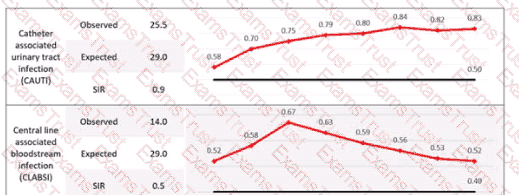
Which of the following should be used to show beginning and ending times for an activity along a timeline?
The ultimate responsibility for ensuring and maintaining patient safety in a healthcare organization lies with the:
Based on the chart below, which of the following should beaddressed first?
Which Is a source of data tor analyzing staff flu vaccination trends for an accountable care organization?
Which of the following regulatory agencies overseedevelopment of electronic clinical quality measures (eCQMs)?
Which of the following best describes how a quality professional should conduct an organizational assessment to ensure safe transitions of care?
A recent analysis reveals that reimbursement projection Is being negatively Impacted by post-surgicalrespiratory failure rates. What Is the first step to address this issue?
A Pharmacy and Therapeutics Committee has reviewed the following control chart for presentation to a governing body:
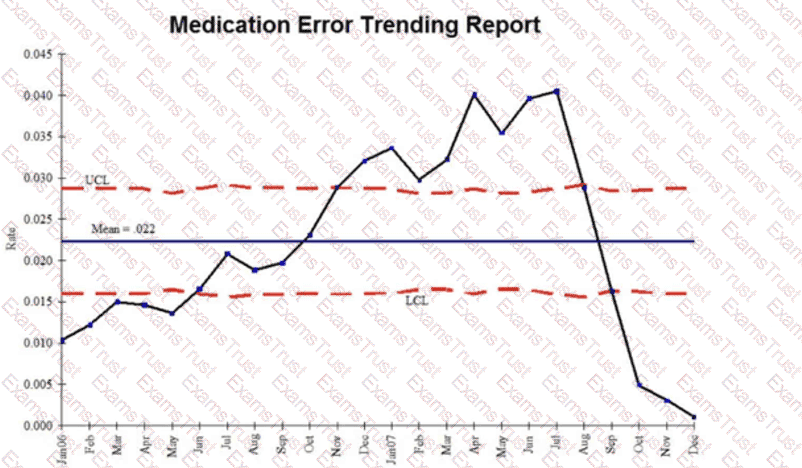
Which of the following conclusions is most appropriate?
A healthcare quality professional is preparing a presentation related to incomplete documentation. According to principles of adult learning, the first step in preparing is to
When compared to the scientific method, which of the following activities is unique to the quality improvement process?
Which tool would be best suited to sequence interventions within a project?
An effective meeting requires which of the following?
A Lean improvement concept that represents rapid improvement is
Which of the following is most effective to sustain knowledge gained from performance improvement training?
Which of thefollowing tools would best display nosocomial infection rates over time?
Which of the following performance improvement models is at the core of the Institute for Healthcare Improvement (IHI) collaborative approach?
A healthcare quality professional Is facilitating the establishment of a Quality Council for an outpatient surgery center. The following positions have been selected for membership: medical director, CEO. and CFO. Which of the following Is the most appropriate Individual to add?
A patient safety officer is developing a patient safety program. The following information has been reviewed:
Incident report data
Performance indicators
Customer complaintsWhich of the following additional information is needed prior to writing the patient safety plan?
An organization with a focus on population health may use data to
Which of the following is the key responsibility of a healthcare quality professional in all types of facilities and organizations?
A CEO and chief nursing officer have requested a new quality initiative to reduce patient falls. One of the first steps in starting this new quality Improvement Initiative should include
In aligning an organization's performance Improvement plan with strategic goals, a healthcare quality professional should consider
During which phase of DMAIC does the quality manager decide which priorities to focus on?
Which of the following tools aids decision-making through organizing tasks, issues, or actions based on agreed-upon criteria?
A healthcare quality professional is looking at a control chart and notices that last November the number of admissions for flu symptoms exceeded the upper control limit. This most likely represents:
One of the first steps in preparing for an organizational accreditation survey Is to have a quality professional
A physician's profile shows a 4% readmission rate following outpatient gallbladder surgery, which Is significantly higher than the rate for their peers.
What action should the quality professional take next?
A performanceimprovement specialist at an ambulatory surgery center is facilitating a Plan-Do-Study-Act Cycle (PDSA) process to improve the rate of hand hygiene amongst surgical post-recovery staff to 90% or above. Data from the past 12 months are as follows:
Baseline: 60% compliance
Q1: 87% compliance
Q2: 79% compliance
Q3: 91% compliance
Q4: 72% compliance
The specialist is preparing to discuss aggregate results with the Quality Committee. To most accurately convey the results, the specialist highlights the
A CEO and CNO have requested a new quality initiative to reduce patient falls. One of the first steps in starting this new quality improvement initiative should include:
In reviewing information offered by the Agency for Healthcare Research and Quality (AHRQ), the quality improvement (QI) specialist recognizes that the three broad aims pursued by the National Quality Strategy are
A healthcare quality professional Is assisting an organization with evaluating patient safety actions that will prevent errors of omission. Which of the following systems will most likely be effective?
Why is it important to convene a multidisciplinary team when conducting a failure mode and effects analysis (FMEA)?
Which of the following would provide the best information to a Quality Council interested in evaluating the effectiveness of quality improvement teams that were chartered during the past year?
Data for an organization's annual Influenza vaccine administration yields the following results:
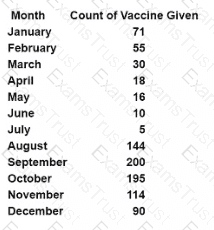
What is the median for the organization's annual vaccine count?
A provider requests to see the peer review file on another provider in their department. What is the healthcare quality professional’s most appropriate response?
Each department in a hospital self-monitors and reports hand hygiene data each quarter. Results typically fall within the 58-72% range, with the exception of Respiratory Therapy, which consistently reports 100% compliance. Which of the following steps should a healthcare quality professional take next?
A healthcare quality professional identifies a statistically significant difference in uncontrolled hypertension between its African American and Caucasian populations. What is the next best step?
To evaluate outcomes, an ambulatory/outpatient care unit should analyze:
Priorities must be established for selecting processes for quality improvement because
A management team is reviewing their near-miss data collectively to identify potential areas of improvement. Which high-reliability principle is being demonstrated?
A healthcare organization has experienced a recent increase in the number of falls with injury. A response by leadership that best demonstrates a safety culture is in place within the organization is to
In a quality improvement team, the primary role of the facilitator Is to
A nurse inadvertently hung an IV medication on the wrong patient’s IV pump, but discovered the error prior to initiating the infusion. Patient harm was averted, and the nurse disclosed the error to a healthcare quality professional. The quality professional should
A nursing unit has collected the following data:
Which of the following is the best method to display this data?
The most important determinant of quality improvement success is
An organization is implementing significant change that affects how staff perform their jobs. Staff members are exhibiting varying levels of acceptance and resistance. Which of the following is the best approach?
A graph shows a 50% complication rate for appendectomies. Which of the following would be most important to assist the reader in interpreting the data?
A surgeon has a surgical site infection rate of 6.7% for a particular procedure. The average infection rate for other surgeons performing the same procedure at this facility is 3.3%. After notifying the department chair of this situation, the quality professional should recommend
The benefits of performing a community health assessment include
The quality manager needs to identify a set of process measures to improve wound care outcomes. The first step should be to
A nurse working a second overtime shift accidentally administered an oral medication via the patient's IV line. The facility reported this to the accrediting body as a sentinel event. Which of the following is the best solution to prevent this error from happening again?
A home health agency has purchased an automated phone notification system to alert nurses that a patient has been discharged from a healthcare facility. The healthcare quality professional should complete which process as a next step?
A quality improvement team develops a new procedure for improving timeliness in reporting urgent lab results to inpatient units. Prior to implementing the new procedure, the team wants to identify any potential deviations from the desired procedure. Which of the following tools should the team use to identify potential deviations?
A hand surgeon is referred for peer review for a case of a wrong-site surgery. Which of the following professionals would be the best choice as a member of the peer review committee?
An organization has a goal to increase profitability of services covered under bundled payments. Which of the following aspects of quality should a healthcare quality professional recommend as a starting point for an analysis?
A quality professional was asked to assist with strategic planning. Which ofthe following should have the primary impact on the quality and performance improvement goals?
Leadership is trying to set SMART goals as part of the annual quality plan. Which of the following meets this framework?
A performance improvement project was initiated at the beginning of the flu season to increase the influenza vaccinations given in a pediatric clinic. The organization implemented a template to document patient influenza vaccine status and to offer the vaccine to any patients identified as not having been vaccinated. To evaluate and document the process improvement results over time, the quality professional should use which of the following?
Population health care management programs are designed to
A customer complains to the health care quality professional about a service in the organization. Which of the following actions should be taken first?
What Is the Initial step the quality professional should take when the organization's performance on a patient satisfaction strategic goal Is below the desired performance?
An example of a clinical care process measure is:
Leadership wants to leverage technology as a strategy for improvement of patient safety. Which of the following best illustrates this is occurring?
An effective way of keeping participants engaged in a meeting is
Which tool is used to establish and track timelines for project completion?
A managed care peer review committee should obtain which of the following first?
Which of the following is the most effective method for communicating an organization’s quality improvement efforts?
Each department in a hospital self-monitors and reports hand hygiene data each quarter. Results typically fall within the 58-72% range, with the exception of Respiratory Therapy, which consistently reports 100% compliance. Which of the following steps should a healthcare quality professional take next?
Which of the following should be a part of an organization's program of continuous readiness for accreditation?
Practice guidelines should be based on
A quality professional is conducting a root cause analysis related to a sentinel event. Which tool would be most useful to identify potential causes of the event?
The health department cited a clinic for storing used instruments improperly. From aquality perspective, which of the following should be done first?
A hospital quality team notices there is an increased number of falls in the inpatient stroke unit. Which of the following is the best method to analyze the issue?
A quality professional's key role in a performance improvement team is to serve as a:
Based on the data below, which unit should the quality Improvement coordinator focus on?

Which of the following Is the best example of effective learning in a learning organization?
A healthcare quality professional has identified a gap In practice from regulatoryrequirements. The quality professional should
Which of the following represents a quality management system with criteria that serve as a tool to assess and award best-in-class organizations?
Using the data below, which issue would be identified as a priority for further performance improvement?
Issue
High Risk
High Strategic Priority
Cost
Customer Satisfaction
Quality Concern
Pressure Injuries
4
4
1
4
5
Medication Errors
3
1
2
1
5
Transfer to Higher Level of Care Within One Hour of Admission
2
5
4
1
3
Miscommunication of Abnormal Findings
4
3
5
1
4
Which management accountability action should be Implemented to ensure continuous readiness tor accreditation survey?
An organization's culture is best assessed by examining the
Which of the following payment systems carries the most financial risk for a provider?
An improvement team is presented with the following information and tasked with deciding which improvement methodology would be most appropriate:
Medication Physician Order to Medication Arrival on Unit
Time in Minutes: Median: 45, Average: 44.3, Goal: 30
Staff Comments:
"The process is too complicated.”
"Why do I need to enter the order into two different systems? There are lots of non-value added steps.”
"We are constantly waiting for the medication to be delivered from the pharmacy, which delays patient care. Why can't we access this medication directly on the floor?”
"The pharmacy overproduces this medication in large batches, which goes wasted.”Based on the information available, which of the following methodologies is most appropriate to address the concerns about the process?
Which of the following should a healthcare plan use to collect satisfaction data from its health plan members?
A Pareto chart can be used to
A quality Improvement team has Identified specific changes to Implement for a quality Improvement Initiative. As the next step, the team would like to establish a concrete timeline for implementation. Which of the following is the best tool to use for this step?
Identification of quality Improvement opportunities can best be Identified through
When allocating limited resources to meet strategic objectives, management decisions should be driven by
A healthcare quality professional identifies a need to improve compliance with colon cancer screening among primary care patients. Which of the following interventions should be used?
Which of the following most accurately describes medication reconciliation?
Performance Improvement plans are most successful when linked first with
Which of the following approaches to the training for a new quality and performance improvement initiative is most likely to succeed based on adult learning principles?
Cold-spotting involves identifying populations that
To assist a primary care physician to improve their performance on a pay-for-performance program, the quality professional should begin with
Which of the following Is an example of active surveillance?
Which of the following Is an example of a population health strategy?
An organization implemented a revised medication reconciliation process 21 months ago. The results of compliance with the revised process were recorded
on a statistical process control chart:
(Use the scroll bar to the right to scroll down as needed.)
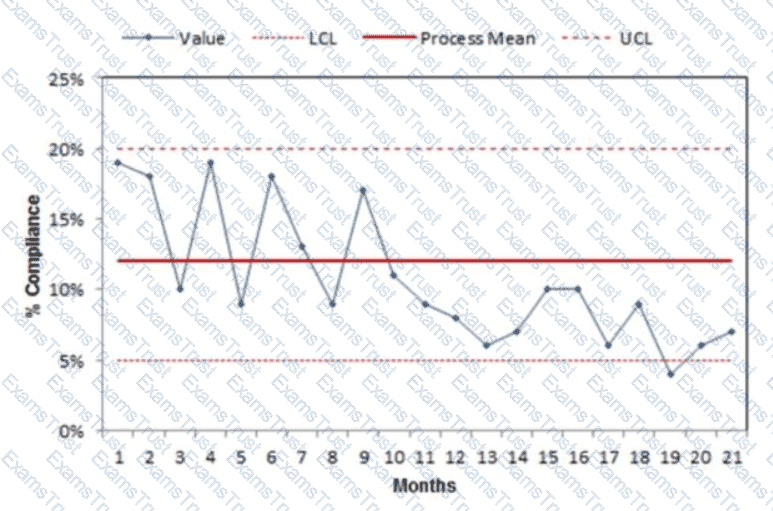
Which of the following should be concluded by a performance improvement coordinator after evaluation of the control chart?
Which of the following best represents an "unsafe condition"?
Evaluating data to determine high utilizers of emergency departments and their related characteristics is a strategy that can best help with
Which of the following actions will most effectively promote safety activities within an organization?
The control chart above indicates which of the following?
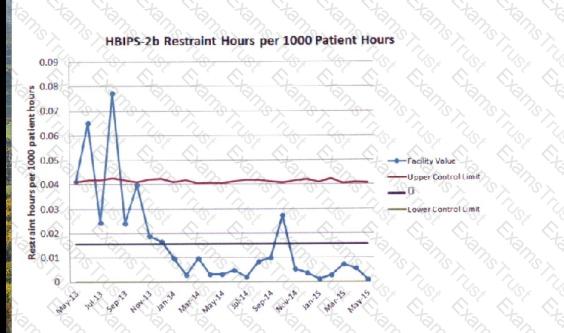
A healthcare quality professional is conducting a study to determine how many patients contracted influenza despite receiving flu shots. This study is evaluating
A healthcare quality professional is asked to evaluate the accuracy of a publicly reported data set. Results from data reviewers showed conflicting information. The results are as follows:
Reviewer
Accuracy
Reviewer 1
80%
Reviewer 2
72%
Reviewer 3
95%
This most likely indicates a problem with:
Which of the following is the most proactive approach to quality improvement?
Which of the following approaches to training for a new quality and performance improvement initiative is most likely to succeed based on adult learning principles?
The process used in management in which organizations evaluate aspects of their processes in relation to best practice in order to make improvements is known as:
Which team role is responsible for maintaining improvements after the implementation of a quality initiative?
An interdisciplinary learn met to review readmission rates at a health system. Issues were identified withcommunication across care providers. The team is interested in improving the coordination of care process and is now reviewing four candidates to serve in the role of process champion:
Of the four candidates, which represents the most effective choice to serve as a process champion?
Which of the following leads to better population health management in older adults with chronic conditions?
Which of the following is the role a healthcare quality professional should play in strategic planning?
Which of the following infection prevention techniques represents a human factors engineering solution?
A goal of measurement is to collect valid and reliable data that reflects
Which of the following tools should be used to determine the root cause of variations in a process?
The expectation to maintain continuous survey readiness must be supported and driven by the
Which of the following is a regulatory requirement to be undertaken by nonprofit hospitals?
An organization that demonstrates a culture of safety
A chart used to display the expected range of variation in a stable process is called a
An organization has a three-year accreditation cycle. The highest priority for the first year of the cycle by the accreditation team is
A multidisciplinary team has been convened to review delays in laboratory turnaround time between the medicine clinic and the laboratory. The team’s first step in evaluating the issue is to
A multidisciplinary team has been convened to review delays in laboratory turnaround time between the medicine clinic and the laboratory. The team's first step in evaluating the issue is to
Where in the process of ensuring correct surgery does a "time-out" take place?
The quality improvement (QI) specialist recognizes that any documents related to medical peer review are:
A healthcare quality professional led a process improvement project to decrease the elapsed time for the stroke protocol. Which of the following tools will best help the quality professional to exhibit project activities and results?
A multi-disciplinary team meets with the goal of reducing Infections In an ambulatory surgery center The group Is struggling to gain focus and come to agreement completing an Ishlkawa diagram. What Is the most likely cause for this challenge?
During development of a clinical pathway, a quality professional should
To integrate performance improvement with organization planning, there must be alignment between
Reviewing organizational priorities, addressing regulatory requirements, and identifying goals for the next year are important components in the development of which of the following?
Continued evaluation of a quality improvement initiative occurs within which of the following phases of the DMAIC process?
A team wants to select a group of patients to measure satisfaction with care. Which of the following is an example of probability sampling?
The process used in management in which organizations evaluate aspects of their processes in relation to best practice in order to make improvements is known as:
Over the past 2 months, a trend has been detected in medication errors. The preferred method of presenting data to the nursing Quality Council will identify the nurse by:
Leadership wants to leverage technology as a strategy for improvement of patient safety. Which of the following best illustrates this is occurring?
A health system in an underserved area seeks to improve medication adherence in patients with hypertension. One of the barriers identified is patients with limited English proficiency. Which of the following solutions will best improve medication adherence?
The most important determinant of quality improvement success is
The most important component of a successful performance improvement program is:
Recognition of the formal and informal structure of an organization is necessary when implementing a quality improvement program because
An organization IsImplementing a new electronic medical record and has employed a project manager. At the first meeting, the project manager observes the following:
• The team estimates It Is one-fourth finished with Identifying benchmark organizations.
• Team members have not yet begun to identify the current state.
- They are halfway through collecting public data, which puts them slightly behind schedule for that task.
Which of the following tools should the quality Improvement project manager recommend?
An interdisciplinary team met to review readmission rates at a health system. Issues were identified withcommunication across care providers. The team is interested in improving the coordination of care process and is now reviewing four candidates to serve in the role of process champion:
Of the four candidates, which represents the most effective choice to serve as a process champion?
Leadership at an outpatient multi-specialty clinic is working toward becoming a high-reliability organization. In the past week, there have been three medication errors with high-risk medications in the procedure area. Which of thefollowing responses by leadership is consistent with high-reliability principles?
The desired outcome of peer review Is to
In a healthcare organization Implementing ongoing performance Improvement (PI), which of the following will most likely benefit the PI goals of the organization?
A quality improvement team is studying the incidence of ear infections in pediatric patients. In addition to the incidence of infection, the team would like to know the predominate age groups affected. Preliminary data indicates that the ages of the patients to be studied are as follows:
1, 1, 1, 1, 1, 2, 2, 3, 4, 4
What is the median age of the patients in this study?
A team has identified five opportunities for improvement related to patient wait times. Which of the following is the best tool for selecting the opportunity with the highest impact?
X quality professional is reviewing medication adherence data for patients with type 2 diabetes. Based on the table below, whichneighborhood should be prioritized for additional interventions?
| Percent of Patients with Type 2 Diabetes Not Taking Medications for 30+ Days | | --- | --- | | Neighborhood | Year 1 | Year 2 | | A | 5% | 10% | | B | 43% | 42% | | C | 20% | 40% | | D | 38% | 44% |
When reporting infection control indicators to a governing body, a healthcare quality professional should demonstrate improvement with which of the following tools?
The upper and lower limits on a control chart are:
Process improvement projects can be evaluated by using
A hospital's leadership team has asked the quality professional to review alternative accreditation options for the organization. The quality professional recommends the:
A healthcare quality professional wants to find out whether the community served Is satisfied with the care provided. The organization serves patients who live within a 10-mile radius. The healthcare quality professional mails a survey to households within 3 miles of the organization. What type of bias has been Introduced?
Which of the following is the best example of applying cultural diversity principles to patient safety?
During a risk assessment, It Is noted that a unit manager and start feel there Is a high risk of aggressive patient behavior toward unit start Which of the following steps should a healthcare quality professional take first?
The culture of safety survey data below is collected from perioperative services. Which action should the healthcare quality professional recommend?

Which of the following approaches best allows an agency to align Its activities with organizational goals?
The performance improvement team developed a prioritization matrix based on the identified improvement opportunities. Based on the information below, what would be the first improvement effort implemented?
Care that does not vary in quality because of gender, ethnicity, geographic location, or socioeconomic status is said to be
A patient was found unresponsive on a medical-surgical floor. Upon review of the patient's medical record, it was found that the patient had accidentally been given two doses of a sedating agent that had not been ordered. Which of the following would have helped prevent this error?
After much planning and preparation, a healthcare quality professional believes the organization is ready to move forward with the process of achieving recognition through a program that highlights their achievements in nursing excellence. Which of the following distinctions is most appropriate for the organization to pursue?
What is the primary purpose of a balanced scorecard?
A skilled nursing facility has implemented a process to address delays in diagnostic test result availability to the ordering provider. Which of thefollowing measurements will best document improvement in this process?
Which of the following is the most effective method to identify adverse events that cause harm to patients?
Evaluating data to determine high utilizers ofemergency departments and their related characteristics is a strategy that can best help with
Refer to the below medication administration audit:
Patient
Medication administered within 1 hour
Was the correct dosage of medication administered?
Were patient allergies confirmed prior to medication administration?
Was medication administration documented in the patient’s record?
Did the patient experience an adverse medication reaction?
A
Yes
Yes
Yes
Yes
Yes
B
Yes
Yes
No
Yes
Yes
C
No
Yes
Yes
Yes
No
D
Yes
Yes
Yes
No
No
Which patient’s record should the quality professional investigate first?
Over the past 2 months, a trend has been detected in medication errors. The preferred method of presenting data to the nursing Quality Council will identify the nurse by
A Pharmacy and Therapeutics Committee has reviewed the following control chart for presentation to a governing body:
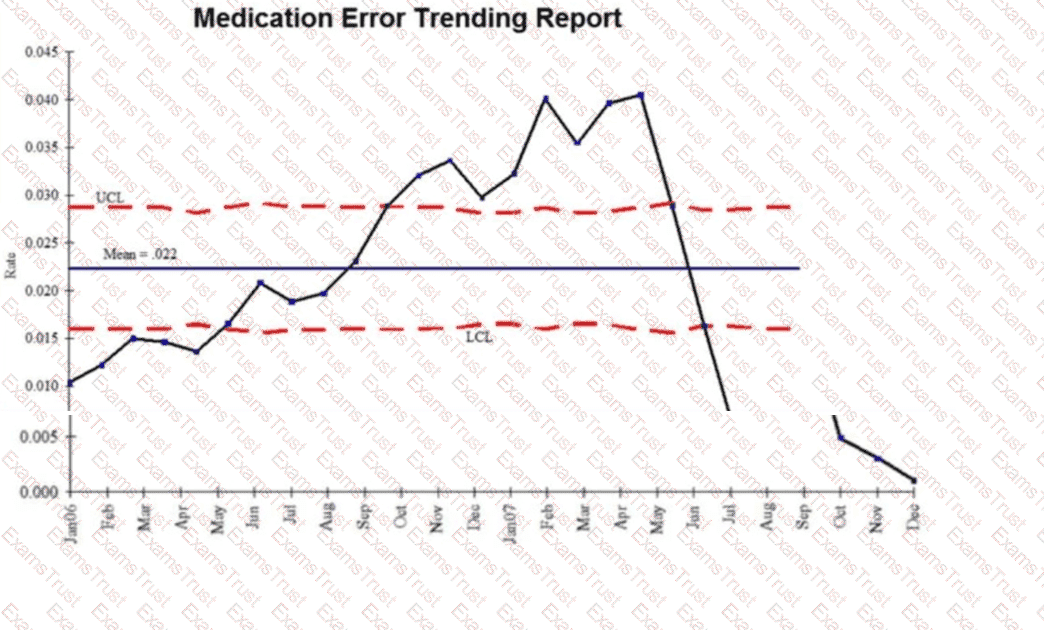 Which of the following conclusions is most appropriate?
Which of the following conclusions is most appropriate?
Ahospital is using the above chart to monitor the average length of stay (ALOS) for patients diagnosed with acute myocardial infarction (AMI). Which of the following conclusions should be made?
A healthcare organization has recently launched a diabetes center of excellence to address the needs of its patients with advanced diabetes. The implementation of this program would fall into which of the following types of prevention?
A healthcare quality professional, previously employed by a hospital, has been hired by an ambulatory surgery center to create a continuous readiness program. Both employers are Medicare certified and are accredited by the same accrediting organization. The healthcare quality professional should first
Which of the following quality improvement tools is best suited for communicating the scope of a proposed quality improvement project?
Hospitals must be in compliance with the Centers for Medicare and Medicaid Services (CMS) Conditions of Participation in order to
The primary purpose of practice guidelines is to
Based on this matrix, which of the following ideas should the team address first?
An organization has established an ambulatory diabetic management program. Which of the following will best define a successful outcome of the program?
Using clinical guidelines based on scientific evidence will most likely
A healthcare quality professional has been hired to assist a quality improvement team with data analysis. In an attempt to enhance the team’s analysis of the data, the quality professional should
Which of the following quality initiatives impacts an organization’s reimbursement?
An organization recently lost its deemed status due to non-compliance with grievance process regulations. Which of the following standards would thequality professional research to identify grievance process requirements to correct the cited opportunities for improvement?
Latent conditions can be described as
Which of the following is true of a clinical pathway?
Consider the following data set:
DRG | Reimbursement | Cost
079 | $4,500 | $15,000
089 | $6,800 | $23,500
127 | $3,500 | $25,000
468 | $8,200 | $12,500
475 | $12,000 | $40,000
Which of the following is the best way to illustrate the relationship between reimbursement and cost?
Which of the following elements of an audit for a primary care office provides information about patient safety?
Supporting patients through longitudinal care plans is the guiding principle of:
Which of the following is a privacy breach according to HIPAA?
The focus for performance Improvement should be
An employee health program includes a pre-employment health assessment for all prospective employees. The assessment is to be completed and the results known prior to the assumption of duties. A retrospective study of 200 employees resulted in the following chart:
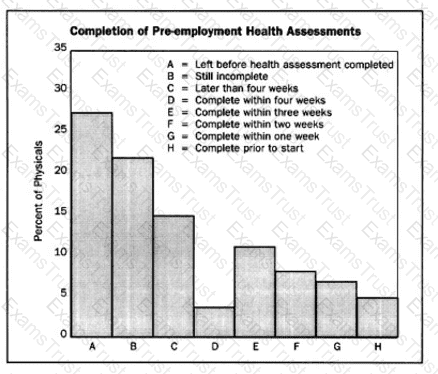
Analysis of the chart shows which of the following conclusions?
A healthcare quality professional is charged with facilitating a team. The goal of the team is to develop criteria for levels of care in behavioral/mental health. Which of the following is the most important characteristic of the facilitator?
The primary focus of Six Sigma methodology is
Which of the following regulatory agencies oversee development of electronic clinical quality measures (eCQMs)?
Which action should be taken to support continuous survey readiness?
A department manager wants to improve customer service. In order to gain employee support, the manager should first
The main purpose of conducting tracers as a part ofcontinuous readiness is to
Which performance improvement tool best evaluates care processes and transitions?
Which of the following is the quality professional's first step prior to implementing a new infection prevention protocol in the clinic?
Six months after implementing a new cardiac rehabilitation program, an organization notes many patients that meet criteria are not enrolled. Which of the following is the most effective strategy to increase the enrollment rate?
A team has identified that labeled cutting boards are needed in a kitchen to decrease cross-contamination. After a new process has been implemented, it is discovered that the labeled cutting boards are not being used. Which of the following is the next action the team should take?
To gauge community perceptions regarding a hospital's response to a pandemic, the healthcare quality professional uses a random number generator to select 1,000 phone numbers and collect survey responses from the first 300 of those phone numbers where the call is answered. All calls are made between 9:00 am and 5:00 pm. This data collection approach is limited because:
Which of the following is an example of an alternative payment model (APM)?
The study of clinic waiting times measures which of the following types of quality indicators?
A root cause analysts (RCA) was conducted tor an event related to a delayed high-priority alarm response. Alarm fatigue was determined to be a root cause. Which of the following Is the most appropriate first Intervention?
A Quality Council has received the following requests for establishing performance improvement teams:
Maintenance: Overtime reductions
Dietary: Meal delivery process
Housekeeping: Room turnaround times
Biomedical: Identification of malfunctioning equipment
Human Resources: Competency assessments
Which of the following should the Quality Council do first?
The healthcare quality professional is tasked with monitoring the monthly fall rates. The fall rate that requires the most immediate investigation is
Prior to a regulatory or accreditation visit, a healthcare quality professional should:
A pay-for-performance structure includes a payout based on achieving the NCQA Quality Compass® 50th Percentile, plus an additional bonus for achieving the NCQA Quality Compass® 75th Percentile. Individual performance on measures is as follows:
NCQA Measure
Physician A
Physician B
Nurse Practitioner C
Physician Assistant D
50th Percentile
75th Percentile
Diabetic Retinal Eye Exam
75%
80%
60%
63%
65%
70%
Nephropathy
53%
43%
50%
48%
50%
52%
HbA1c Testing
76%
80%
52%
70%
72%
76%
Which provider will not earn pay-for-performance based on reaching either the NCQA Quality Compass® 50th or 75th percentile?
After a sentinel event, a root cause analysis (RCA) is performed. Which of the following should be included in the RCA?